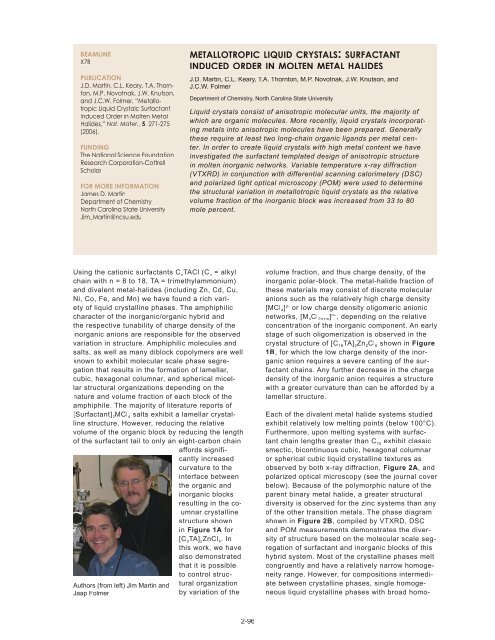NSLS Activity Report 2006 - Brookhaven National Laboratory
NSLS Activity Report 2006 - Brookhaven National Laboratory
NSLS Activity Report 2006 - Brookhaven National Laboratory
You also want an ePaper? Increase the reach of your titles
YUMPU automatically turns print PDFs into web optimized ePapers that Google loves.
BEAMLINE<br />
X7B<br />
PUBLICATION<br />
J.D. Martin, C.L. Keary, T.A. Thornton,<br />
M.P. Novotnak, J.W. Knutson,<br />
and J.C.W. Folmer, “Metallotropic<br />
Liquid Crystals: Surfactant<br />
Induced Order in Molten Metal<br />
Halides,” Nat. Mater., 5, 271-275<br />
(<strong>2006</strong>).<br />
FUNDING<br />
The <strong>National</strong> Science Foundation<br />
Research Corporation-Cottrell<br />
Scholar<br />
FOR MORE INFORMATION<br />
James D. Martin<br />
Department of Chemistry<br />
North Carolina State University<br />
Jim_Martin@ncsu.edu<br />
Using the cationic surfactants C nTACl (C n = alkyl<br />
chain with n = 8 to 18, TA = trimethylammonium)<br />
and divalent metal-halides (including Zn, Cd, Cu,<br />
Ni, Co, Fe, and Mn) we have found a rich variety<br />
of liquid crystalline phases. The amphiphilic<br />
character of the inorganic/organic hybrid and<br />
the respective tunability of charge density of the<br />
inorganic anions are responsible for the observed<br />
variation in structure. Amphiphilic molecules and<br />
salts, as well as many diblock copolymers are well<br />
known to exhibit molecular scale phase segregation<br />
that results in the formation of lamellar,<br />
cubic, hexagonal columnar, and spherical micellar<br />
structural organizations depending on the<br />
nature and volume fraction of each block of the<br />
amphiphile. The majority of literature reports of<br />
[Surfactant] 2MCl 4 salts exhibit a lamellar crystalline<br />
structure. However, reducing the relative<br />
volume of the organic block by reducing the length<br />
of the surfactant tail to only an eight-carbon chain<br />
affords significantly<br />
increased<br />
curvature to the<br />
interface between<br />
the organic and<br />
inorganic blocks<br />
resulting in the columnar<br />
crystalline<br />
structure shown<br />
in Figure 1A for<br />
[C 8TA] 2ZnCl 4. In<br />
this work, we have<br />
also demonstrated<br />
that it is possible<br />
to control struc-<br />
Authors (from left) Jim Martin and<br />
Jaap Folmer<br />
METALLOTROPIC LIQUID CRYSTALS: SURFACTANT<br />
INDUCED ORDER IN MOLTEN METAL HALIDES<br />
J.D. Martin, C.L. Keary, T.A. Thornton, M.P. Novotnak, J.W. Knutson, and<br />
J.C.W. Folmer<br />
Department of Chemistry, North Carolina State University<br />
Liquid crystals consist of anisotropic molecular units, the majority of<br />
which are organic molecules. More recently, liquid crystals incorporating<br />
metals into anisotropic molecules have been prepared. Generally<br />
these require at least two long-chain organic ligands per metal center.<br />
In order to create liquid crystals with high metal content we have<br />
investigated the surfactant templated design of anisotropic structure<br />
in molten inorganic networks. Variable temperature x-ray diffraction<br />
(VTXRD) in conjunction with differential scanning calorimetery (DSC)<br />
and polarized light optical microscopy (POM) were used to determine<br />
the structural variation in metallotropic liquid crystals as the relative<br />
volume fraction of the inorganic block was increased from 33 to 80<br />
mole percent.<br />
tural organization<br />
by variation of the<br />
2-96<br />
volume fraction, and thus charge density, of the<br />
inorganic polar-block. The metal-halide fraction of<br />
these materials may consist of discrete molecular<br />
anions such as the relatively high charge density<br />
[MCl 4] 2- or low charge density oligomeric anionic<br />
networks, [M nCl 2n+m] m- , depending on the relative<br />
concentration of the inorganic component. An early<br />
stage of such oligomerization is observed in the<br />
crystal structure of [C 16TA] 2Zn 2Cl 6 shown in Figure<br />
1B, for which the low charge density of the inorganic<br />
anion requires a severe canting of the surfactant<br />
chains. Any further decrease in the charge<br />
density of the inorganic anion requires a structure<br />
with a greater curvature than can be afforded by a<br />
lamellar structure.<br />
Each of the divalent metal halide systems studied<br />
exhibit relatively low melting points (below 100°C).<br />
Furthermore, upon melting systems with surfactant<br />
chain lengths greater than C 10 exhibit classic<br />
smectic, bicontinuous cubic, hexagonal columnar<br />
or spherical cubic liquid crystalline textures as<br />
observed by both x-ray diffraction, Figure 2A, and<br />
polarized optical microscopy (see the journal cover<br />
below). Because of the polymorphic nature of the<br />
parent binary metal halide, a greater structural<br />
diversity is observed for the zinc systems than any<br />
of the other transition metals. The phase diagram<br />
shown in Figure 2B, compiled by VTXRD, DSC<br />
and POM measurements demonstrates the diversity<br />
of structure based on the molecular scale segregation<br />
of surfactant and inorganic blocks of this<br />
hybrid system. Most of the crystalline phases melt<br />
congruently and have a relatively narrow homogeneity<br />
range. However, for compositions intermediate<br />
between crystalline phases, single homogeneous<br />
liquid crystalline phases with broad homo-

















